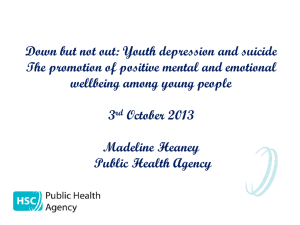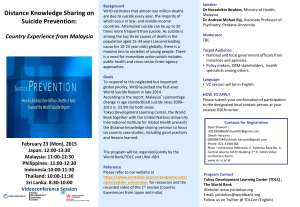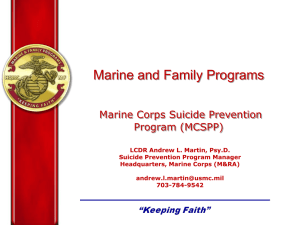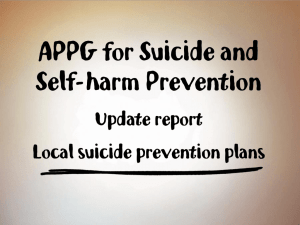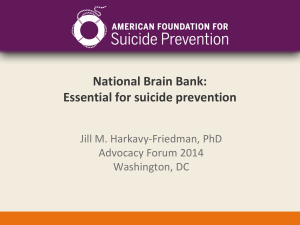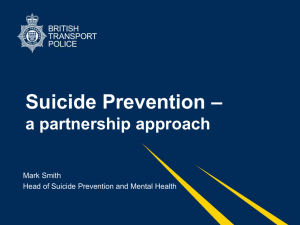Document
advertisement
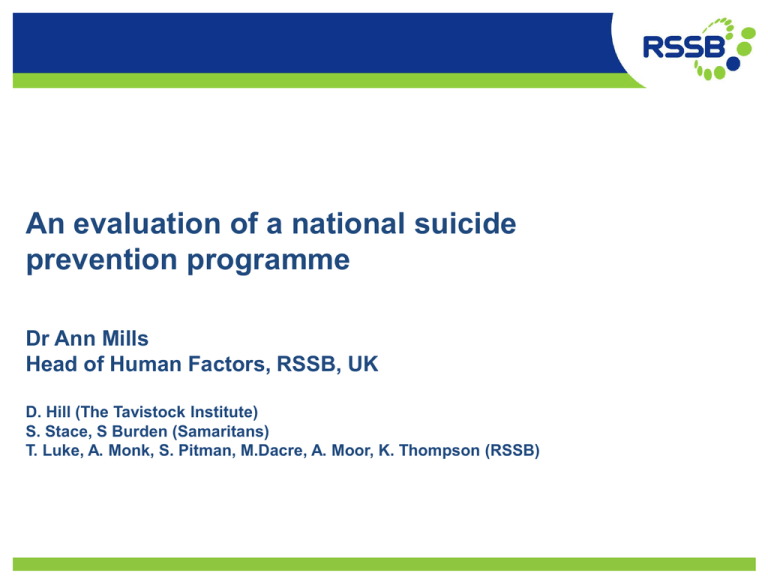
An evaluation of a national suicide prevention programme Dr Ann Mills Head of Human Factors, RSSB, UK D. Hill (The Tavistock Institute) S. Stace, S Burden (Samaritans) T. Luke, A. Monk, S. Pitman, M.Dacre, A. Moor, K. Thompson (RSSB) Historical railway fatalities Comparing suicides to trespass fatalities 5 times 80% of more recorded fatalities attempted as a result suicides of suicide resultattempt in a fatality than trespass 350 Number of fatalities 300 250 Suicides 200 Trespass 150 Accidental fatalities: passenger 100 Accidental fatalities: workforce 50 0 2006-7 2007-8 2008-9 2009-10 2010-11 2011-12 The national picture in relation to railway suicides • Estimated that there were 6,045 suicides in the UK in 2011, or one every 87 minutes • Twice as likely to die by suicide as in a road traffic accident • More men than women take their own lives • Around 80% of railway suicides are by men • Men aged 30-55 are the highest risk group Programme details Partnership working • National Suicide Group • Identification of priority locations • Joint suicide prevention plans • Development of guidelines and polices • Wider third part engagement Prevention • Managing suicide contacts training (MSC) • Public awareness campaign (posters, leaflets & contact cards, signs) • Physical measures (barriers) • Outreach (ESOB) Postvention • Suicide trauma support training (TST) • Post incident support • Guidance to rail staff/industry on responding to media enquiries In Stations At Level Crossings Posters Programme & Evaluation challenges • Complex, evolving programme, involving lots of parties • Programme gaining momentum & impact – delay in results • Level of engagement influenced by views on whether it is a societal issue or railway issue to manage, experience, number of manned stations….. • Challenges in consistent delivery of programme • Impact being felt not just at priority locations • Other parties undertaking activities that are not formally ‘part of programme’ • Changes in suicide rates – too crude a measure? Example Theory of Change map Issues Actions Route and TOC reps appointed Priority locations identified Anticipated rise in suicides Proven interventions not being used Staff training developed Managing Director instructs Station Managers Route Reps send info on courses Head of Stations nominate staff Staff recruited for training (in sufficient numbers) Outcomes Staff proactive in identifying other risks Change in staff attitudes and confidence to intervene Impacts Other interventions put in place (physical measures, links to other local initiatives) (More) staff identify potential suicides and intervene Number of rail suicides reduced Network rail team site visits Folders, cards and posters distributed Sources of data Outputs Interviews with Samaritan team and trainers Staff use folders and other materials Samaritan data on numbers/roles/ location of attendees Data on referral patterns of network rail and TOC reps (interviews) Increased understanding of Samaritan’s role Post course questionnaires Staff survey (WP6) for evidence of changes in knowledge, attitudes and confidence Staff proactive in ensuring posters displayed/using call out service Data on staff interventions WP2 and WP6 Data on partnership working at a local level WP4 More people aware of and using Samaritans Data on rail suicides WP1 identifies any connections between suicides and programme interventions Evaluation methods 1. 2. 3. 4. 5. Analysis of number of suicides Analysis of delay minutes, costs and staff absenteeism Survey of partners Station/Intervention case studies Front line staff survey Programme roll-out Y1 2010/11 Y2 2011/12 Y3 2012/13 Priority locations 175 237 254 Priority locations with posters 105 191 152 Priority locations with ESOB capability 63 159 251 ESOB activations 0 1 7 MSC courses 91 130 159 Staff trained - MSC 940 1315 1211 Staffed trained - TST N/A 187 631 Staff interventions 10 25 22 Post incident support - offered 172 253 Post incident support - accepted 78 42 Reduction? 300 Other locations Level crossing 250 In stations 225 234 225 207 Fatalities 200 189 150 96 20 25 20 73 77 72 85 119 25 25 100 94 97 23 33 26 22 50 75 105 100 100 18 102 113 203 107 131 238 218 193 123 238 90 94 80 0 2003/04 2004/05 2005/06 2006/07 2007/08 2008/09 2009/10 2010/11 2011/12 2012/13 Rail vs national picture 400 8000 On railway property All suicides 350 5826 5731 5850 6045 5671 5554 5377 5706 5675 6000 5608 245 250 206 200 184 196 206 204 207 219 4.4% 3.2% 3.4% 225 5000 214 4000 150 3.5% 7000 3.8% 3.6% 3.6% 3.9% 3000 4.0% 3.5% 100 2000 50 1000 0 0 2002 2003 2004 2005 2006 2007 2008 2009 2010 2011 National suicides Railway suicides 300 Railway suicides as % of national total Impact at priority locations 90 81 80 74 68 70 57 60 50 40 79 49 45 43 56 56 53 39 30 20 10 0 2001 2002 2003 2004 2005 2006 2007 2008 2009 2010 2011 2012 Priority locations 2012 Cost and Disruption TRUST delay costs and SMIS delay minutes: TRUST Costs (£) SMIS delay (mins) 2009 / 10 19,841,000 298,143 2010 / 11 11,033,000 227,860 2011 / 12 20,716,000 391,267 2012 / 13 2009 2 hours 44 mins 296,112 2012 1 hour 59 mins Partnership working Establishment of National Suicide Prevention Steering Group & Working Group 87% felt programme improved partnership working 77% felt programme reduced staff distress 77% felt programme had reduced service disruption 37% felt good practice effectively implemented nationally Perceived effectiveness of programme activities Perception of how effective each programme activity is at reducing suicides 0% 10% 20% 30% 40% 50% 60% 70% 80% 90% 100% Physical barriers Samaritans Metal signs MSC training Posters Local suicide prevention plans External engagement Samaritans info for staff ESOB Risk assessments Memorials policy Would increase the number of suicides Don’t know Would decrease the number of suicides Perceived effectiveness of programme activities at reducing staff distress Perceived effectiveness of programme activities at reducing staff distress 0% 10% 20% 30% 40% 50% 60% 70% Trauma support training ESOB Samaritans information for staff MSC training Increases distress No effect Decreases distress 80% 90% 100% Effect of the programme on relationship between your organisation and other organisations Perceived effect of programme on relationships with different organisations 0% 10% 20% 30% 40% 50% Samaritans Own organisation Train Operating Companies BTP Network Rail Worse No effect Better 60% 70% 80% 90% 100% Willingness to participate in programme activities Staff willingness to take part in programme activities 0% 10% 20% 30% 40% 50% 60% 70% 80% 90% 100% TST Local suicide prevention plans MSC Samaritans info for staff External engagement Station risk assessment ESOB Would/might refuse to take part Don’t know Willing/keen to take part Introduction to the ATTS • 24 item survey • Respondents rate agreement with attitude statements e.g. ‘It is a human duty to stop someone taking his/her life’ • Factors: – – – – – – – Obligation to prevent Acceptance of suicide Unpredictability of suicide Suicide as a long lasting issue Suicide as a taboo subject Reasons why people take their own life Preventability of suicide Effect of MSC training on attitudes Participation in MSC training and attitudes Average attitude score (max 5) 0 0.5 Yes No 1 Obligation to prevent Attitude factor Preventability Openness/acceptance of suicide Reasons why people take their own life Unpredictability of suicide Suicide as a long-lasting issue* Suicide as a taboo subject to talk about Overall 1.5 2 2.5 3 3.5 4 4.5 Frontline staff attitudes compared to ‘management’ attitudes Oganisational level and attitudes 0 0.5 1 Average attitude score (Max = 5) 1.5 2 2.5 3 3.5 4 Obligation to prevent* Attitude factor Preventability* Openness/acceptance of suicide* Suicide as a long-lasting issue* Suicide as a taboo subject to talk about* Unpredictability of suicide* National level respondents (N ~ 52) Local level respondents (N ~ 670) 4.5 5 Recognition of people who might be suicidal Participation in MSC training and whether staff have seen someone they suspected of being suicidal Seen someone once or more than once Never seen anyone 0% 10% 20% 30% 40% 50% 60% 70% 80% 90% 100% Participation in MSC No Participation in MSC Yes MSC training and interventions Whether an intervention has been made if someone was suspected of suicide Attended MSC Not attended MSC 0% 10% 20% 30% 40% 50% 60% 70% 80% 90% 100% No Yes once or more than once Effect of MSC training on intervention actions Average likelihood to take an action (Max = 5) Tell them you know how they feel* Give advice about how to solve problems Physically restrain them Request Samaritans ESOB service Ask for permission to pass contact details to Samaritans* Approach and ask how they are* Provide Samaritans contact details* Encourage the person to talk and listen* Introduce yourself and ask their name* Try to show empathy and understanding* Contact BTP Offer safe place to go to talk* 0 Attendance at MSC training Yes (N ~ 83) 0.5 1 1.5 2 2.5 3 3.5 4 Attendance at MSC training No (N ~ 212) 4.5 5 Summary of findings • • • • • • • • • Evaluation of a programme of this nature is challenging Partnership working had improved as a result of the programme Wide variations in level of implementation No evidence to date to suggest programme has led to reduction in number of suicides, reduction in delays or cancelations BUT Improvement in response times. Staff willingness to be involved is high Programme activities are perceived as being effective at reducing suicides and staff distress. MSC training has had a positive effect on the ability of staff to recognise when someone is suicidal and on the quality of the interventions. The rate of interventions when someone is recognised as potentially suicidal is high regardless of MSC training. Thank you Dr Ann Mills ann.mills@rssb.co.uk

